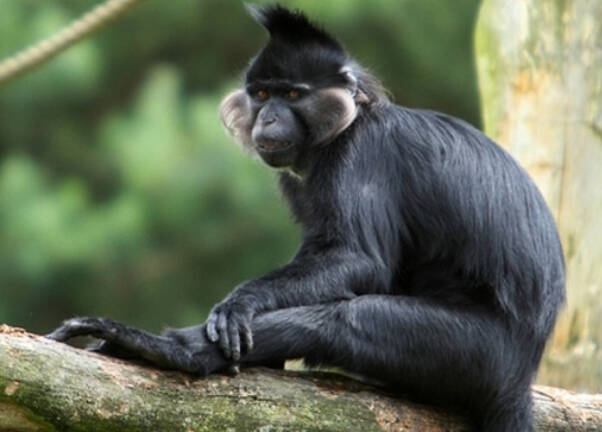Lophocebus aterrimus
IUCN
LCBasic Information
Scientific classification
- name:Lophocebus aterrimus
- Scientific Name:Lophocebus aterrimus,Black Mangabey
- Outline:Primates
- Family:Cercopithecidae Cercopithecidae
Vital signs
- length:45-65cm
- Weight:4-10kg
- lifetime:No verification information
Feature
The top of the head has a tall black crest and white eyelids.
Distribution and Habitat
Distributed in Angola and the Democratic Republic of Congo. They live in Africa, from plains to low hills, in areas close to water sources, and in secluded areas with food. They like to live in forest and shrub areas, especially in valleys with streams and rivers, and in vast areas with vines and green trees, which are often the most ideal places for monkeys to live.
Appearance
The black-capped white-maned monkey is a medium-sized, slender monkey. The head and body are 45-65 cm long; the tail is 80-85 cm long; the male weighs 6-10 kg and the female weighs 4-7 kg. It is a large arboreal monkey with a tall black crest on the top of its head and white eyelids, hence the name. There are whiskers on both sides of the cheeks that bend outward. The snout is long, and the thumb can be opposite to the other four fingers. The limbs are long, and the upright tail is longer than its body. The tail is not entangled and is usually upright and curved above the back. The body is almost all black hair, with a slightly lighter belly. The color of the shoulders varies and differs between the two subspecies, ranging from gray to brown.
Females are slightly smaller and more slender than males. Males have special air sacs in their throats that can loudly amplify and clearly announce the existence and location of their tribe. There are cheek pouches for storing food.
Details
Black Mangabey (scientific name: Lophocebus aterrimus) is a medium-sized arboreal monkey with two subspecies.

Black Mangabey lives in groups, usually 9-16 individuals, with multiple males and multiple females forming a family group. Each group lives in a family territory of about 48 to 70 hectares, which may overlap with the territories of other family groups. There is a strict hierarchy within the close-knit group. They often like to climb vines and trees, and like to find cliff caves. Their range of activities is very large. When the monkey group moves collectively, there will be a "sentinel" standing on a high place to keep watch. If an abnormal situation is found, it will send a signal to call the monkey group to move quickly. If the situation is urgent, they will quickly disappear without a trace with their skilled skills in climbing cliffs. The monkey group members will comb each other's hair and touch each other. They are active during the day and are most active in the early morning and dusk. On the surface, they usually move slowly and leisurely. But in fact, they are agile, with fast speed and reaction.
Black-crowned white-maned monkeys usually forage in the middle and upper parts of the canopy layer 12 to 30 meters above the ground. It is able to leap up to 5 meters between trees, but may occasionally venture onto the forest floor in search of food. Most foraging occurs in the morning, and the diet consists mainly of flowers, young leaves, nectar, bark, fruit, nuts, seeds, leaves, and young branches. The species has strong incisors and flat molars that can crack nut shells and crush hard seeds, and has occasionally been recorded preying on small mammals. They have large cheek pouches that can be used to store food.
Little information is available about the reproductive biology of wild black-crested white-maned monkeys. In the Democratic Republic of the Congo, black-crested white-maned monkeys have been recorded giving birth during the rainy season in July and August. A single young is usually produced after a gestation period of 5-6 months.
Listed in the 2008 Red List of Endangered Species of the World Conservation Union (IUCN) ver 3.1 - Near Threatened (NT).
Listed in the Appendix II of the Washington Convention on International Trade in Endangered Species (CITES).
Protect wild animals and eliminate game.
Maintaining ecological balance is everyone's responsibility!








